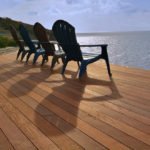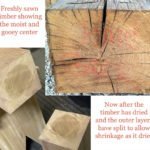Over the past several months we have written about tropical decking choices, Ipe importing seasons, and Ipe pricing fluctuations. This week we want to talk about some of the issues to be aware of while installing and working with tropical decking lumber like Ipe and Cumaru.
Ipe Decks Can Be Rough When First Installed

To maximize the stability of exterior lumber and to showcase consistent vertical grain striping on the face, a lot of decking lumber is quartersawn. This exposes some of the internal structure of the tree called medullary rays.
These rays are the mechanism the tree uses to transport nutrients from the outer layers of the tree to the inner layers. They are very dense and will not plane and smooth as easily. The result is that even straight from the mill, these quartersawn boards may need some touching up with a sander to get them smooth.
It is not a defect of the lumber, but rather a naturally occurring structure. This is not unique to tropical hardwoods, but because they are so hard, it can be more noticeable than in pressure treated lumber or softwoods like cedar.
Ipe Decking Problems Due to Warping

Decking products of all kinds – whether Cumaru, pressure-treated pine, or Ipe – have much higher moisture contents than lumber used for interior projects. These decking products are not kiln dried, but they have instead been air dried, leaving them in the 14-18% moisture range. These moisture levels are necessary for an outdoor product to remain stable.
If the boards are kiln dried to below 8% moisture, then they would be left very “thirsty” and would move and soak up a lot of moisture if moved to a humid climate or during the first rain. By keeping the moisture content higher, we prevent large swings in moisture content and thereby prevent rapid expansions of the wood. Different climates will react differently to this, and an acclimatization period is therefore essential. Your decking lumber should be stored out of direct sunlight and should be provided with good air flow for a recommended period of 2-3 weeks in the same climate as the job site. This allows the wood to come into equilibrium with the local conditions. During this acclimatization period the wood could expand or contract as much as 1/8″ on 4″ wide boards and 1/4″ on 6″ boards, so it is essential to let the wood move before it is screwed to a rigid sub-structure.

Once installed on the deck, proper ground side ventilation will ameliorate movement throughout the life of the deck and should therefore be a necessity when designing it. This is especially true for ground level decks as this air flow will let the whole deck board expand and contract evenly as the seasons change.
Finally, proper end sealant should be used any time the boards are cut to length. Wood is just like a bundle of straws, and moisture will come and go most quickly from the ends. Each time fresh end grain is exposed, the moisture will change quickly right at the cut. An end sealer like Anchorseal will slow this moisture change. Rapid change can cause splits and checks to appear in the board, which is never attractive.
Ipe Wood Problems due to Hardness
Ipe, Tigerwood, Massaranduba, Cumaru and most tropical woods are very dense and very hard. Hard woods require sharp tools, and dense woods will split easily if not properly pre-drilled. All decking should be pre-drilled before installing screws, but this isn’t like pressure treated material that will compress easily as a screw is driven in. Larger holes need to be drilled, and only the most robust cordless drills and drivers can stand up to the workload required to drill through a material that is 6 times harder than pressure-treated pine. It is important to take into account the added time and labor needed to install a tropical hardwood deck. It is a good idea to have some extra drill bits on hand. Don’t be surprised if you break a few during installation.
Next week we will talk some more about hidden fastener systems, as this is a topic all on its own.
Ipe Decking Problems Due to Mismatch in Color

Wood is an organic material, so it will vary in color and grain pattern, even among boards of the same species. In truth, it is this variation that makes it so beautiful. However, pressure treatment and staining of some species unifies a lot of these variations. On the other hand, composite decking is dyed for consistency (somewhat, but that’s a topic for another day), so a homeowner or contractor used to dealing with these engineered products may be surprised when their load of tropical hardwood has more variation in color than they expect. Ipe, for example, is grown across a very wide area. As it is brought into saw mills and distribution centers from the forest, many locations are combined into one. All of these locations have many factors that affect the growth and color of the living tree, so when they are all thrown together, variation is to be expected.
Freshly sawn lumber can be very different in appearance from the final product. The lumber will oxidize and change color over time. Teak color change is a well known issue, but it is typical to find some color change in all woods. In most cases, the color variation will mellow and blend into a more cohesive match. Decking will eventually grey with exposure unless specifically treated to prevent this sun “bleaching”.
Tropical hardwoods make outstanding decks. Their lifespan and low maintenance simply cannot be beaten, so they will continue to be very popular for some time to come. The above issues should not deter anyone from using Ipe or Cumaru because these issues are very easily resolved, especially with the help of a professional. Our hope is that this knowledge will help to make the installation of your tropical hardwood deck run smoothly. The most important thing to consider is that these woods come from very far away, and they are cut very far in advance of being put to use. Many times they will have touched multiple continents, sat in lumber yards for months on end, and been moved by crane, truck, and forklift. It is therefore to be expected that some boards will need a little extra work to smooth out. Care will be needed to get the best color match and show face. In the end, that extra care is what separates a good deck from an outstanding deck.
Learn more about the lumber industry:









Leave a Reply